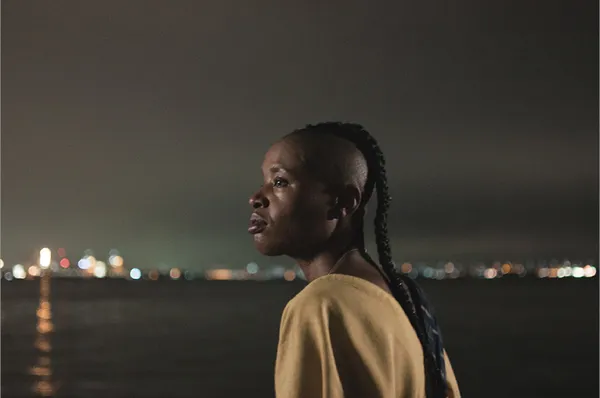Eye For Film >> Movies >> Formosa Beach (2024) Film Review
Formosa Beach
Reviewed by: Sergiu Inizian

Julia De Simone's slow-burning exploration of heritage and resilience opens with a striking image of a 19th-century black woman staring at modern Rio de Janeiro from an archaeological site. This beautiful shot signals that Formosa Beach aims to study the interplay between past and present and revisit history through the eyes of those wronged by it. The result is a visually rich experience that boldly breaks down stylistic conventions, resulting in a dream-like atmosphere that vividly conjures the spectres of a troubled past.
The experimental narrative leaps between past and present and is tied together by Muanza (Lucília Raimundo), an African woman brought to colonial Brazil as an enslaved woman. Her connection to Kieza (Samira Carvalho), another woman forced into servitude constitutes the story's emotional core. They rely on their bond, taking turns reading and caring for each other's hair. We see them planning to run away, tracing the escape route on their bodies. Focusing on physical features, De Simone rediscovers the history of Rio de Janeiro through a palpable identity that was suppressed under colonial rule.

Suddenly separated from her close friend and transported to a dilapidated mansion, Muanza seeks answers where there might be few. She encounters the matron of the house, who orders her around, unaware of the peculiar situation they find themselves in. The protagonist’s journey takes an eerie turn as it becomes apparent that her surroundings are stuck in time. Marco Scarassatti's score intensifies the strange feeling, with a haunting polyphony between a breath-like melody and an intense chiming that signals the possibility of Kieza's permanent disappearance.
Shot in a visually rewarding 4:3 format, Formosa Beach brims with visual refinement. The interaction between pastel colours, particularly teal and mauve, creates a graceful tint around De Simone's vision of the 19th century. Stepping into present-day Brazil, Muanza's presence strikes the eye, contrasting with the unadorned aesthetic of modern life. As she starts spontaneously dancing, the gliding camera dignifies her perseverance and engagingly captures her passage into a new world.
De Simone employs a hybrid style of filmmaking to reexamine the strength of a heritage which was once erased. Muanza acts as a guide through this history, her obscure but rich journey casting a spell over the viewer. Documentary-like scenes offer context to her story, revealing a much-needed alternative record of Rio de Janeiro's colonial past. At times, the anthropological focus overshadows esthetic considerations. Detailed discussions resembling interviews delve into archaeological trinkets and religious practices, detracting from the oneiric allure of an experience that thrives on mystery.
Muanza's longing eyes tell much of the story in Formosa Beach. From the very first moment she stares at the modern life of Rio de Janeiro, De Simone weaves a vibrant story of survival and kinship. An equally beautiful and enigmatic chronicle that conjures the past to challenge the present. But Muanza is not merely a ghostly reminder of a controversial history. Instead, she embodies an ongoing tale of rediscovery, a testament to resilience and the revival of a valuable cultural legacy.
Reviewed on: 06 Feb 2024

















